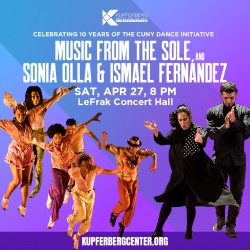Testimony to the Committee on Cultural Affairs, Libraries, and International Intergroup Relations: Oversight Hearing on NYC’s Immigrant Communities and the Arts
Thursday, January 12, 2023
Testimony to the Committee on Cultural Affairs, Libraries, and International Intergroup Relations: Oversight Hearing on NYC’s Immigrant Communities and the Arts
Thank you for your consideration of this testimony, submitted on behalf of Dance/NYC (dance.nyc), a service organization that represents over 5,000 individual dance artists, 1,200 dance-making entities, 500 non-profit dance companies, and the many for-profit dance businesses based in the metropolitan New York City area. Its areas of service are of special benefit to BIPOC (Black, Indigenous, and Peoples of Color), immigrant, disabled, low-income and small budget dance workers.
Dance/NYC joins colleague advocates working across creative disciplines to acknowledge and celebrate the important contributions of immigrant communities to arts and culture in NYC and reiterate the ways that the artistry of this community must continue to be supported. Dance/NYC supports both Res 0424-2022 and Res 0331-2022 that have been proposed by Council Members Sandra Ung and Christopher Marte, respectively, to recognize Lunar New Year as a school and official New York City holiday.
Immigrant New Yorkers are deeply and historically embedded in the social, economic, and cultural fabric of our city. Immigrant New Yorkers are a major economic force in New York City and their contribution is vital to the city’s economic health. According to data from the Mayor's Office of Immigrant Affairs (MOIA), immigrants comprise 36% of New York City’s total population and 43% of its workforce, own half of the city’s businesses, and in 2019 alone, contributed an estimated $244 billion to the city’s Gross Domestic Product (GDP) or 23% of the city’s GDP. The American Immigration Council estimated that in 2018, immigrant-led households in New York paid $35.4 billion in federal taxes and $21.8 billion in state and local taxes.
Immigrant artists are a cultural force that fuel the city’s creative energy, pushing technical and creative boundaries, preserving cultural heritage, and helping anchor New York City’s global leadership in contemporary arts and culture. Immigrant artists comprise a growing share of the city’s artists - an estimated 50,964 in 2018, a 69% increase from 1990. In 2021, immigrants accounted for nearly one-third of all artists in New York City, helping drive the growth and success of the arts and culture sector in the city. Immigrant artists often play multiple roles, their contribution to the city extending far beyond their individual works. They serve as anchors in their communities, mentors to the next generation, and as leaders in arts and cultural organizations serving immigrant communities and facilitating community engagement and cross-cultural conversations. A Dance/NYC study shows that the immigrant dance workforce is ethnically and racially diverse, that immigrant dance workers are investing in their communities as leaders, activists and healers, and are innovating new models, challenging traditional rules of dance and tackling pressing social and political issues of our times. Other Dance/NYC demographic findings, include:
- The majority of the immigrant dance workforce (71%) identified as first generation immigrants with almost half of respondents (44%) having been based in the United States for more than 15 years.
- The majority of immigrant respondents (68%) is based outside Manhattan.
- The immigrant dance workforce skews young, with 60% of respondents being Millennials and 26% belonging to Generation X.
- The immigrant dance workforce skews female, outpacing the City’s foreign born population that identifies as female (53%).
- The percentage of the immigrant dance workforce identifying as LGBTQ+ is substantial at 19%.
- The majority of the immigrant dance workforce is working predominantly outside the nonprofit structure, with 40% working as an independently/privately financed artist or group and 17% working as a fiscally sponsored artist or group.
- The overwhelming majority of the immigrant dance workforce indicated working in disciplines in addition to dance (88% working across an average of 1.89 other disciplines) and in multiple roles in the dance field (87% working an average of 3.5 roles).
Despite their tremendous output and significant contributions, immigrant New Yorkers continue to face socio-economic inequities and significant barriers to full inclusion. Immigrant New Yorkers continue to experience higher poverty rates despite working more hours and participating in the labor force at the same or greater rate than US-born New Yorkers. The higher poverty rate among immigrant New Yorkers can be attributed, in part, to the fact that median income varies significantly based on immigration status - the average median earnings for immigrant workers is $38,200 compared to $52,500 for US-born New Yorkers. In addition to disparity in pay and median earnings, immigrant workers experience persistent gaps in access to health insurance coverage and other work-related benefits. This disparity in median earnings is reflected in a 2020 study by the Center for an Urban Future showing that immigrant artists in New York City made nearly $15,000 less than their US-born counterparts, leaving them with less time for artistic pursuits in their daily struggle to survive.
Immigrant artists in New York City face distinct and additional challenges. Immigrant artists struggle to get attention from funders, mainstream media, and presenters, which hinders their ability to build an audience and get mainstream recognition. Immigrant artists also struggle to get paid fairly - a Dance/NYC 2019 study finds that 22% of immigrant dance workforce reported not receiving any income for dance-related work that they do, feel undervalued in their contributions to our city, and encounter several other legal and societal barriers to accomplishing their work. The immigrant dance workforce ranked affordable presentation space and living wages as their highest needs, followed by affordable development space, affordable healthcare, and affordable living space, and affordable legal assistance, among others. The large majority of immigrant-serving arts organizations do not own their space, making them more vulnerable to perpetual rent hikes and real estate crunch.
Differential access to funding is a persistent and structural barrier for many. Immigrant artists and immigrant-serving arts organizations earn 14 times less in programming revenues and receive 6 times less in corporate funding. They are more dependent on public funding but receive far less than their counterparts. A comparison of DCLA per capita spending on arts and culture demonstrates the stark difference: $15.37 in Manhattan compared to $0.74 spending in ten neighborhoods with the largest concentration of immigrants.
The COVID-19 pandemic has exacerbated and made stark persistent structural, institutional racism and pre-existing socio-economic inequities in the city. A 2020 MOIA study shows that while immigrant New Yorkers made up over 50% of the frontline workers providing critical medical care and essential services to the public that kept the city going at the height of the pandemic, communities in the city with significant concentration of immigrants experienced 20% higher case rate and 40% higher death rate from COVID-19 than citywide averages while they faced barriers to accessing health insurance and being shut out of pandemic relief services due to their immigration status.
Immigrant artists and immigrant-serving arts organizations have been hit especially hard by the COVID-19 pandemic and the economic crisis that ensued. A COVID-19 Impact Study by Dance/NYC shows immigrant dance workers reporting a 45% average decrease in annual income between 2019 and 2020 as compared to 33% of US-born dance workers. In particular, disabled, African, Latina/o/x, Asian, Arab, and Native American (ALAANA), immigrant, and older individual dance workers, as well as dance workers who are also parents and dance workers living in the Bronx, have been disproportionately impacted. Thirty-two percent (32%) of immigrant dance workers needed medical health care coverage as compared to the 15% of those born in the US. Immigrant-led and immigrant-serving arts organizations have reported revenue losses amounting to 50% or more of their annual budgets, a fiscal hardship that many may not be able to recover from.
In times of hardship there is a reason for optimism: Dance [by immigrant artists] is important. It is our legacy beyond frontiers.
– Christopher Núñez, a visually impaired choreographer, dramaturg, educator and disability advocate based in NYC
(Excerpt from “Dancing in the Shadows of Invisibility,” an essay by Christopher Núñez in Dance/NYC (2019): Advancing Immigrant. Dance. Arts.
Dance/NYC is committed to advancing justice, equity, and inclusion in the arts and culture sector and we offer the following recommendations for the city government and public agencies to foster the inclusion, integration, and human rights of immigrant dance artists, cultural workers, and communities:
- First and foremost, invest in immigrant organizations, programs, and projects:
- Develop immigrant-specific programs by both arts funding initiatives and project funding initiatives: for example, production support for dance addressing immigrant rights, and general support initiatives;
- Integrate immigrant matters as a funding priority in existing arts portfolios;
- Expand purview of funding to ensure small-budget groups, fiscally sponsored projects, independent artists, and unincorporated groups that are immigrant-led or are meaningfully integrating immigrants are served.
- Remove restrictions to funding sources based on immigrant status and, if not possible, provide transparent information on eligibility of noncitizen applicants.
- Support immigrant artists and organizations in identifying and accessing funding by expanding technical assistance and training and offering materials in multilingual content.
- Expand arts education programs and strengthen partnerships between immigrant-led arts organizations and city schools. Artistic practices, such as dance, teaches many lessons that support learning, such as empathy, tenacity, communication, and inquiry. Dance education can be an incentive for students to do well in their academic classes. By giving immigrant students access to dance education, the DOE supports their core mission to educate young people.
- Expand legal and resource assistance programs to support immigrant artists and arts organizations.
- NYC Council should pass both Res 0424-2022 and Res 0331-2022 that have been proposed by Council Members Sandra Ung and Christopher Marte, respectively, to recognize Lunar New Year as a school and official New York City holiday to recognize and honor the contributions and impact of Asian Americans communities to our city’s culture and economy.
Immigrants helped build and continue to shape New York City as the global economic and cultural force that it is today. Dance/NYC calls on the City to do its part to ensure that immigrant artists and cultural workers continue to thrive here.
###




